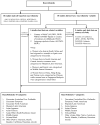The InterLACE study: Design, data harmonization and characteristics across 20 studies on women's health
- PMID: 27621257
- PMCID: PMC5378383
- DOI: 10.1016/j.maturitas.2016.07.021
The InterLACE study: Design, data harmonization and characteristics across 20 studies on women's health
Abstract
Objectives: The International Collaboration for a Life Course Approach to Reproductive Health and Chronic Disease Events (InterLACE) project is a global research collaboration that aims to advance understanding of women's reproductive health in relation to chronic disease risk by pooling individual participant data from several cohort and cross-sectional studies. The aim of this paper is to describe the characteristics of contributing studies and to present the distribution of demographic and reproductive factors and chronic disease outcomes in InterLACE.
Study design: InterLACE is an individual-level pooled study of 20 observational studies (12 of which are longitudinal) from ten countries. Variables were harmonized across studies to create a new and systematic synthesis of life-course data.
Main outcome measures: Harmonized data were derived in three domains: 1) socio-demographic and lifestyle factors, 2) female reproductive characteristics, and 3) chronic disease outcomes (cardiovascular disease (CVD) and diabetes).
Results: InterLACE pooled data from 229,054 mid-aged women. Overall, 76% of the women were Caucasian and 22% Japanese; other ethnicities (of 300 or more participants) included Hispanic/Latin American (0.2%), Chinese (0.2%), Middle Eastern (0.3%), African/black (0.5%), and Other (1.0%). The median age at baseline was 47 years (Inter-quartile range (IQR): 41-53), and that at the last follow-up was 56 years (IQR: 48-64). Regarding reproductive characteristics, half of the women (49.8%) had their first menstruation (menarche) at 12-13 years of age. The distribution of menopausal status and the prevalence of chronic disease varied considerably among studies. At baseline, most women (57%) were pre- or peri-menopausal, 20% reported a natural menopause (range 0.8-55.6%) and the remainder had surgery or were taking hormones. By the end of follow-up, the prevalence rates of CVD and diabetes were 7.2% (range 0.9-24.6%) and 5.1% (range 1.3-13.2%), respectively.
Conclusions: The scale and heterogeneity of InterLACE data provide an opportunity to strengthen evidence concerning the relationships between reproductive health through life and subsequent risks of chronic disease, including cross-cultural comparisons.
Keywords: Baseline characteristics; Chronic disease; Cross-cultural comparison; Harmonization; Life-course research; Reproductive health.
Copyright © 2016 Elsevier Ireland Ltd. All rights reserved.
Conflict of interest statement
The authors have no conflicts of interest to declare.
Figures



References
-
- Wernli KJ, Ray RM, Gao DL, De Roos AJ, Checkoway H, Thomas DB. Menstrual and reproductive factors in relation to risk of endometrial cancer in Chinese women. Cancer Causes Control. 2006;17:949–955. - PubMed
-
- Janghorbani M, Mansourian M, Hosseini E. Systematic review and meta-analysis of age at menarche and risk of type 2 diabetes. Acta Diabetol. 2014;51:519–528. - PubMed
MeSH terms
Grants and funding
- U01 AG012554/AG/NIA NIH HHS/United States
- MC_UU_12019/1/MRC_/Medical Research Council/United Kingdom
- R01 AG017578/AG/NIA NIH HHS/United States
- R01 AG017644/AG/NIA NIH HHS/United States
- U01 AG012505/AG/NIA NIH HHS/United States
- U01 AG012531/AG/NIA NIH HHS/United States
- S06 GM008073/GM/NIGMS NIH HHS/United States
- RG/13/2/30098/BHF_/British Heart Foundation/United Kingdom
- U01 AG012535/AG/NIA NIH HHS/United States
- U01 AG012553/AG/NIA NIH HHS/United States
- U01 NR004061/NR/NINR NIH HHS/United States
- U01 AG012539/AG/NIA NIH HHS/United States
- P30 NR004001/NR/NINR NIH HHS/United States
- U01 AG012546/AG/NIA NIH HHS/United States
- MR/K013351/1/MRC_/Medical Research Council/United Kingdom
- PG/11/63/29011/BHF_/British Heart Foundation/United Kingdom
- U01 AG012495/AG/NIA NIH HHS/United States
LinkOut - more resources
Full Text Sources
Other Literature Sources
Medical

